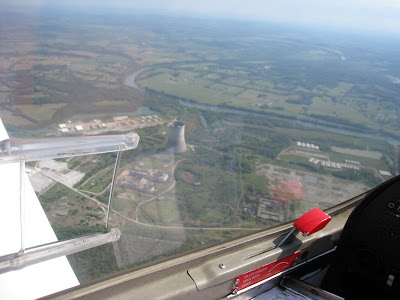I did discuss with my CFI all of the static I was receiving during my last flight while communicating with flight following. There are two different radios on the aircraft, and he suggested I use the other one.
As safeguards, I again elected to request flight following and set the GPS for a direct flight. I took off of Smyrna runway 19 and ascended to an altitude of 5,500 feet and set my heading.
 |
| Smyrna Airport |
Once I reached my desired altitude, I noticed I was closer to the clouds than preferable. As a pilot permitted to fly VFR (Visual Flight Rules), I am not allowed to fly in clouds, but I must also stay clear (usually 500 to 1,000 feet) of clouds for two reasons:- The VFR pilot does not want to take the chance of drifting, due to wind or turbulence, into a cloud.
- The VRF pilot will want to avoid collision with an IFR (Instrument Flight Rules) pilot who emerges from the cloud.
I descended to 3,500 feet and flew the rest of the flight that way.
At only about 27 degrees Celsius (81 degrees Fahrenheit) it was actually cool in the cockpit with the small windows open, but is made for a comfortable flight. I didn’t have any major problems, but since it was very rural, I wasn’t able to spot it until I was about 3.5 miles away. In addition, as I approached the airport, it started to rain. I was nervous as I had not expected to fly in rain today, and I was worried it would be a problem. When it comes to weather, the factors for safe flight are more about visibility and wind strength. Neither of them seemed to be a problem, so I proceeded to the airport.
 |
| Aproching TZV - See, the airport can be hard to spot! |
There were no other aircrafts in sight, but I called out my intentions to land as I would have if there was. I was little gun shy on landing. It had been about 10 days since I landed this plane and I wasn’t happy with the results at that time. I set myself up for landing on runway 22. As I came in on final, I was higher than preferable, since it was raining, I wanted to give myself as much runway to stop just in case it was slick. I aborted the landing and flew the pattern one more time.
My next approach was much better and my landing was a smooth one I could be proud of. This landing helped restore my confidence.
Since TZV is such a small airport, there was no taxiway, so you have to taxi back on the runway and turn the plane around. There was a spot just off the runway where I could re-set the GPS and radio frequencies. As I was re-setting the frequencies, I review the one I had for TZV (which is listed as 123.05) and saw that I had set the frequency of 123.50. If there was anyone around, they may not have heard me calling my location and intentions. This situation wasn’t ideal, but I didn’t break any FAA laws, as radio communications is not required at this airport. That being said, I’ll need to be more careful in the future.
As I made my way back to the other end of the airport saw the rain was slowing down. Yet when I turned the plane around, I saw it was still raining at the other end of the 4,000 foot runway.
 |
| Sunny to the north |
I took off without a problem, but I was headed towards the rain. It looked like it was just one cloud. Once I was past that cloud, it was sunny the rest of the flight.
 |
| Under the rain cloud |
 |
| Sunny a couple of minutes later |
I was able to take a picture of a checkpoint I found on the chart.
 |
| The blue "cone" means there is an obsticle - in the case they call it a Cooling Tower |
 |
| Can you see it? |
The rest of the flight was uneventful and I had another smooth landing on runway 19.
Flight time: 1.70 hours – Pilot in Command
Cost: Plane rental - $159.80, Instructor Fee - $0.00



No comments:
Post a Comment